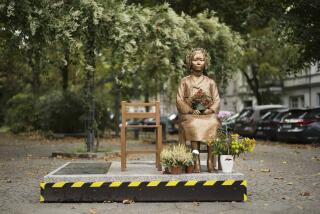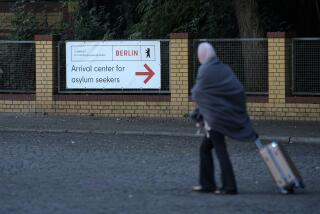U.S. May Sit Out Berlin Revival
- Share via
BERLIN — Of all the renovated streets and plazas of this soon-to-be-rebuilt capital, the most splendid is to be Pariser Platz, the square directly in the late-afternoon shadows of Berlin’s pillared Brandenburg Gate.
Already, a stately hotel is nearing completion on the square, prestigious future bank buildings are tantalizingly veiled by scaffolding and plans have been selected for the future French and British embassies.
The United States is to be part of Pariser Platz’s restored classical elegance too. But when?
A decision to build the new U.S. Embassy here was announced in 1991, soon after Germany’s Bundestag, or lower house of Parliament, voted to return the federal government to Berlin from Bonn. It was Washington’s way of affirming support for German reunification, underscored by the selection of Pariser Platz, the prewar home of the U.S. Embassy.
Last summer, the Santa Monica architectural firm of Moore Ruble Yudell won a competition for the new embassy’s design. And then--nothing.
The project, it turns out, is hostage to the austerity mood in Washington. Diplomats tried to get around the resistance by promising that no congressional appropriations would have to be made for the new building--it could be funded from the sale of other U.S. properties in Germany.
But that promise was made when Germany was reaching the heights of its post-unification boom and Berlin real estate prices were much higher than now. A key piece of the financing puzzle was to be a 30-acre, outlying parcel that the U.S. Army bought in 1946 and used as a home for Radio in the American Sector, or RIAS, a station that competed with the occupying Soviets’ German-language broadcasts. The station disappeared at the end of the Cold War, though its antenna still stands. U.S. planners initially hoped to sell the land for about $80 million.
No way. The garbage incinerator on one side of the property makes an undesirable neighbor, as does the recycling plant on another.
U.S. negotiators have slashed its price to $40 million, but there is still no sale. Now they are talking about rezoning the land for commercial use; the city of Berlin, though, won’t allow it.
“Perhaps Berlin should pay for the Americans’ embassy if they can’t afford it themselves,” said one Berlin official who didn’t want to be identified. “But I don’t quite understand why other countries can afford it--even Macedonia, I recently heard.”
Clearly, some Berliners are annoyed by Washington’s refusal to throw open the public purse, particularly now when the U.S. economic model is being touted as an example for Germany to follow because Washington is so much better at creating jobs.
But among other Berliners, the U.S. thrift isn’t offensive, just baffling. It was the U.S., after all, that saved West Berlin from being starved into the arms of the Soviet Bloc in 1948-49, when Moscow blockaded the city and Washington retaliated with round-the-clock food airlifts.
Many older Berliners still carry with them an image of Americans that no public relations campaign could possibly create: of kindly, selfless young airmen, chucking candy bars out of airplanes in the cold of winter and the dead of night.
Such memories have prompted one aging local lawyer to write to his favorite newspaper, calling on his fellow Berliners to join in a fund-raising drive. He even enclosed a $600 check, but his idea didn’t catch on.
*
Meanwhile, the nonexistent embassy has become a favorite topic of cocktail party chitchat here. One suggestion has it that the State Department should go back to Congress and admit that it needs an appropriation after all. Another idea is to wait until real estate prices go up again, then sell the RIAS site.
A worst-case scenario has America selling its costly and tradition-laden land on Pariser Platz, then using the proceeds to build an embassy in a low-rent district, far away from Berlin’s future center of wealth, power and style.
More to Read
Sign up for Essential California
The most important California stories and recommendations in your inbox every morning.
You may occasionally receive promotional content from the Los Angeles Times.










